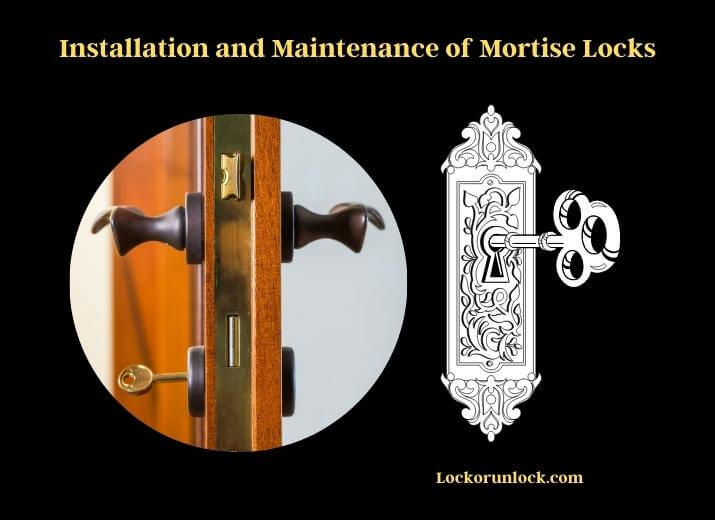Mortise locks have been used for centuries to secure doors and provide added protection against unauthorized entry. These locks are known for their reliability, durability, and strength, making them a popular choice for many homeowners and businesses. Unlike other types of locks, mortise locks require a pocket, or mortise, to be cut into the door in order to install the lock. This provides a secure fit for the lock and makes it more difficult for intruders to tamper with or bypass it.

Mortise locks come in a variety of styles and finishes, making them a versatile option for any decor. They are typically made from durable materials such as brass, steel, or bronze, ensuring their longevity and resistance to wear and tear. With proper installation and maintenance, mortise locks can last for many years, providing peace of mind and security for you and your family.
History of Mortise Locks
Mortise locks have a long and fascinating history, dating back to ancient times. The earliest known mortise locks were found in the ruins of the Palace of Khorsabad in Iraq, which dates back to the 8th century BC. These early locks were made from wood and consisted of a bolt that slid into a hole in the door frame. A wooden key was used to unlock the bolt, making it one of the earliest examples of a key-operated lock.
Over time, mortise locks became more advanced and were used in many cultures throughout the world. In the Middle Ages, mortise locks were made from iron and were often highly decorative, featuring intricate patterns and designs. During the Renaissance, mortise locks became even more ornate, with locks made from gold, silver, and precious stones.
In the 18th and 19th centuries, mortise locks became more practical and functional, with a focus on security and durability. The Chubb brothers, Charles and Jeremiah, were pioneers in the development of the modern mortise lock, and their designs are still used today.
Today, mortise locks are widely used in residential and commercial buildings around the world. They are known for their strength and reliability and are considered one of the most secure types of locks available. Despite their long history, mortise locks continue to be a popular choice for those who value security and durability in their locks.
Anatomy of a Mortise Lock
Mortise locks are made up of several key components that work together to provide security and functionality. Understanding the anatomy of a mortise lock is important when selecting and installing a lock on your door.
Lock Body
The lock body is the main part of the mortise lock and houses the mechanisms that control the bolt and latch. It is typically made from brass, steel, or bronze and is designed to fit into the mortise cutout in the door.
Deadbolt
The deadbolt is a solid metal bolt that extends from the lock body into the door jamb when the lock is engaged. It provides extra security and makes it more difficult for intruders to force the door open.
Latch
The latch is a metal plate that is attached to the lock body and protrudes from the edge of the door. It holds the door closed when the lock is not engaged and is typically spring-loaded for ease of use.
Strike Plate
The strike plate is a metal plate that is attached to the door jamb and aligns with the latch when the door is closed. It provides a surface for the latch to engage with and helps to keep the door securely closed.
Keyhole
The keyhole is where the key is inserted to unlock the lock. It is typically located on the face of the lock body and may be round or rectangular in shape.
Knob or Lever
The knob or lever is part of the lock that is turned or pressed to engage or disengage the lock. Knob locks are a fundamental component of residential and commercial security systems. It is typically located on the inside of the door and may be made from a variety of materials such as brass, steel, or wood.
Cylinder
Some mortise locks have a cylinder that is inserted into the lock body and controls the bolt and latch. The cylinder is typically made from brass or steel and can be keyed to match other locks in the building.
Types of Mortise Locks
There are several different types of mortise locks available, each with its unique features and advantages.
Single Cylinder Mortise Lock
This type of mortise lock has a keyhole on one side and a thumb turn on the other. The key is used to unlock the lock from the outside, while the thumb turn is used to lock and unlock the door from the inside.
Double Cylinder Mortise Lock
This type of mortise lock has a keyhole on both sides, requiring a key to unlock the door from both the inside and outside. This type of lock is often used on doors with glass panels to prevent intruders from breaking the glass and reaching in to unlock the door.
Mortise Deadbolt Locks
A mortise deadbolt lock is a type of lock that is commonly used to secure doors. It consists of two parts: a mortise lock and a deadbolt. The mortise lock is installed inside the door and is typically operated by a key or a thumb turn. It has a latch bolt that can be retracted by turning the key or thumb turn.
Classroom Mortise Lock
This type of mortise lock is commonly used in schools and other public buildings. It has a keyhole on the outside and a lever on the inside, which can be locked or unlocked using a key. This allows the teacher or instructor to lock the door from the inside during class, while still allowing authorized personnel to enter with a key.
Storeroom Mortise Lock
This type of mortise lock is commonly used in commercial buildings, such as warehouses and storage facilities. It has a keyhole on the outside and a fixed lever on the inside, which cannot be unlocked. This ensures that the door is always locked from the outside, but can be easily opened from the inside in case of emergency.
Privacy Mortise Lock
This type of mortise lock is commonly used in bathrooms and bedrooms. It has a thumb turn on the inside and a keyhole on the outside, but the key can only be used to unlock the door in case of emergency. This provides privacy and security while still allowing for easy access in case of need.
Mortise Hook Bolt Locks
A mortise hook bolt lock is a type of door lock that is installed within the door itself rather than being attached to the surface. The lock has a rectangular-shaped box called a mortise that is embedded within the door and a latch bolt that extends into the door frame. The hook bolt is a unique feature of this type of lock, which engages with the strike plate to provide additional security.
Installation and Maintenance of Mortise Locks
Proper installation and maintenance of a mortise lock are essential for ensuring its longevity and effectiveness in providing security.

Installation
Installing a mortise lock requires careful measurement and precision cutting to ensure that the lock body fits snugly into the mortise cutout in the door. It is recommended to hire a professional locksmith (a locksmith can indeed install a deadbolt for you0 for installation to ensure that the lock is installed correctly and securely.
Lubrication
Mortise locks require periodic lubrication to prevent wear and tear on the mechanisms and to ensure that the lock operates smoothly. Use a high-quality lubricant designed specifically for locks and apply it to the keyhole, latch, and bolt as needed.
Cleaning
Regular cleaning of the lock and its components can help prevent dirt and debris from accumulating and interfering with the lock’s operation. Use a soft, dry cloth to wipe down the lock and its components, and avoid using harsh chemicals or abrasive materials.
Adjustment
Over time, a mortise lock may become loose or misaligned, which can affect its effectiveness in providing security. Regularly check the lock for any signs of wear or misalignment, and make any necessary adjustments or repairs promptly.
Key Maintenance
Proper key maintenance is also important for ensuring the longevity and effectiveness of a mortise lock. Avoid using worn or damaged keys, and consider having spare keys made in case of loss or damage.
Advantages of Mortise Locks
Mortise locks offer several advantages over other types of locks, making them a popular choice for both residential and commercial applications.
Strength and Durability: Mortise locks are known for their strength and durability, thanks to their solid construction and design. They are designed to withstand heavy use and provide reliable security for years to come.
Resistance to Tampering: Mortise locks are designed to be tamper-resistant, making them more difficult for intruders to bypass. The lock body is recessed into the door, making it harder to manipulate or pick the lock.
Versatility: Mortise locks come in a variety of styles and configurations, making them suitable for a wide range of applications. They can be used on both residential and commercial doors, and are available in different finishes to match any decor.
Aesthetics: Mortise locks offer a classic and elegant look that can enhance the aesthetics of any door. They come in a variety of designs and finishes, making it easy to find one that complements the style of your home or business.
Functionality: Mortise locks offer a high level of functionality, with options for keyless entry, privacy settings, and more. They are also available in different grades to provide varying levels of security, depending on your needs.
Last Remarks
Mortise locks have a long history of providing reliable and effective security for doors in both residential and commercial settings. Their solid construction, tamper-resistant design, and versatility make them a popular choice for those looking for a high level of security and functionality.
Whether you are renovating an old home or building a new one, mortise locks are an excellent choice for securing your doors. With a variety of styles, finishes, and functionality options available, it’s easy to find a mortise lock that fits your needs and complements the look of your home or business.
Remember, proper installation and maintenance are crucial for ensuring the longevity and effectiveness of your mortise lock.
